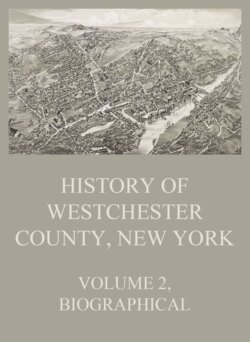Читать книгу History of Westchester County, New York, Volume 2 - Группа авторов - Страница 8
На сайте Литреса книга снята с продажи.
STUYVESANT, PETER
ОглавлениеIn 1650 Peter Stuyvesant, on behalf of the colony of New Netherland, had a conference with the authorities of Connecticut at Hartford, which resulted in a provisional treaty of the boundary that the line should "begin at the west side of Greenwich bay, being about four miles from Stamford, and so run a northerly line twenty miles up into the country, until it shall be notified by the two governments of the Dutch and of England, provided the said line come not within ten miles of the Hudson river." This agreement was never sanctioned by the home governments, and thirteen years later, on the 13th of October, 1663, a second conference was held, at which Connecticut proposed " that Westchester and all ye people of lands between that and Stamford shall belong to their colony of Connecticut till it be otherwise issued," which proposition was refused by the agents of Governor Stuyvesant, who proposed that " West Chester, with the land and people to Stamford, shall abide under the government of Connecticut till the tyme that the bounds and limits betwixt the abovesaid colony and the province of New Netherland shall be determined heare (by our mutual accord or by persons mutually chosen, — margin) or by his Royal Majesty of England and other high and mighty lords of the estates of the united provinces. "
War breaking out between England and Holland, this agreement or treaty was never ratified by the home governments. Finally new regulations were adopted, and Peter Stuyvesant was appointed director-general. It was hoped that he would also prove a "redresser-general." He came to New Netherland in 1646 and assumed the reins of government as the successor of Kieft.
Stuyvesant's administration was an energetic one on the part of the director-general, but he was beset with difficulties on every hand. He was anxious to insist on the Dutch claim to all the territory from the Connecticut to the Delaware rivers, which the English settlers were as emphatic in denying. The English pushed their settlements almost to the Harlem river. On Long Island they claimed entire independence of New Netherland. Stuyvesant had further troubles with the Indians up the Hudson. The internal affairs of his government were very jarring. Jealousies and disputes were frequent. He was stern in his assertion of authority, but that authority was but poorly respected. To add to his difficulties, he was very insufficiently supported by the college of the company in Amsterdam. The unfortunate organization of the company became more and more apparent. New Netherland was a financial burden. When, therefore, in 1664, in utter disregard of the rights and authority of the Dutch, the King of England gave to his Jarother, the Duke of York and Albany, the territory between the Connecticut and Delaware rivers, and Richard Nichols, as lieutenant-governor, with a fleet of four ships and four hundred men, appeared before New Amsterdam, the colony was ripe for a change, and, despite the earnest protests of Stuyvesant, quietly surrendered, and the Dutch authority ceased. It was restored, for a short period only, in 1673.
Peter Stuyvesant was born in Holland in 1602, and died in New York city, in August, 1682.
